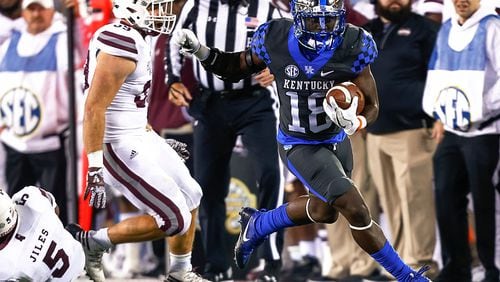Georgia Tech’s season will have a bookend that epitomizes the transfer trend that has filtered into college football. The Yellow Jackets began the season in Ireland defending Boston College quarterback Patrick Towles, a graduate transfer from Kentucky.
They’ll finish it facing the quarterback whom Kentucky recruited out of junior college to replace Towles, Stephen Johnson.
Beyond an unusual footnote, it could be a critical factor in the outcome of the TaxSlayer Bowl matchup Dec. 31 in Jacksonville, Fla. Johnson’s elevation to the starting job early in the season helped shape the Wildcats’ offensive identity, one that particularly found its footing over the second half of the season.
“They’ve been scoring a bunch of points and moving the ball and hitting a lot of big plays and doing it with a bunch of players,” defensive coordinator Ted Roof said.
Johnson — who began his career at Grambling, then spent the 2015 season at a California junior college before coming to Kentucky in January 2016 — became the starter after the No. 1 quarterback, Drew Barker, suffered a back injury in the second game of the season and ultimately needed season-ending surgery. Johnson started eight of the final nine regular-season games.
Wildcats co-offensive coordinator Eddie Gran helped Johnson find his way by leaning heavily on running backs Stanley “Boom” Williams (from Monroe, about halfway between Atlanta and Athens) and Benny Snell. In the process, Kentucky figured out that its offensive line was quite capable at run blocking and that the 220-pound Snell served well in a finishing role.
Against power-conference competition, Kentucky averaged 3.7 yards per carry in the first half of the season (facing Alabama and Florida’s stout defenses was a factor), but 6.2 in the second half. Playing softer defenses in the back half helped, but the Wildcats finished the regular season with a dominant performance against Louisville, which ranks fourth in the country in defensive yards per rush at 2.99 yards per attempt.
Kentucky ran up 229 rushing yards on the Cardinals and averaged 5.33 yards per carry. The 229 yards were the most allowed by Louisville, and only No. 2 Clemson had a better per-carry average against Louisville this season. Kentucky’s run-game dominance spurred the Wildcats’ 41-38 road upset of their in-state rival, then ranked No. 11 and trying to position itself for an Orange Bowl berth. Kentucky broke its five-game losing streak to the Cardinals, another achievement in coach Mark Stoops’ fourth season. The Wildcats are bowling for the first time since the 2010 season.
Kentucky's 63/37 run/pass ratio is the 13th highest run-heavy ratio in the country, according to teamrankings.com. It was unusually high for Gran, who ran 48, 48 and 52 percent of the time in his three seasons as offensive coordinator at Cincinnati before his hire at Kentucky last December.
To no one’s surprise, Tech is fifth at 77/23.
On the Dec. 4 teleconference with coach Paul Johnson and Stoops to announce the bowl matchup, Johnson joked, “If Mark’ll promise not to throw it, we will, too.”
Kentucky operates out of the shotgun and uses the wildcat and read-option as part of its package. Snell and Williams can run wild in open space and also have tackle-breaking strength. Both cleared 1,000 rushing yards. Johnson, the quarterback, is also a threat to run on draws and off the option.
“They have three awesome running backs — No. 3 (Jojo Kemp), No. 26 (Snell) and No. 18 (Williams),” cornerback Lamont Simmons said, “and they like the wildcat, so it’ll be a great opportunity to face the run and get a lot of tackles.”
“Going against the wildcat, you’ve got to especially fit in your right gaps, play your responsibility,” linebacker P.J. Davis said. “Also, they’ve got a good quarterback that runs the ball, so we’ve got to stay responsible, make sure we’re reading our keys and everything.”
It will be a weighty challenge for Tech, which has had its moments in defending the run but ranks 90th in defensive yards per carry (4.78). The exact same could be said for Kentucky’s defense, which is 105th at 5.14 yards per carry.
Tech did show improvement in the final quarter of the regular season, particularly against Virginia Tech (121 rushing yards on 33 carries) and in a passable run-defense effort against Virginia (189 yards on 42 carries). Georgia stuck the Jackets for 263 rushing yards on 42 attempts. Overall, the Jackets did fairly well at avoiding big run plays but not at all so at creating negative-yardage plays.
The bowl game will be the final impression that the Jackets leave on 2016. If they can contain Kentucky, it will go a long way toward legitimizing the improvement at the end of the season.



/cloudfront-us-east-1.images.arcpublishing.com/ajc/P7DYBH6TO7FEKG4SUXQQKADRXE.jpg)



